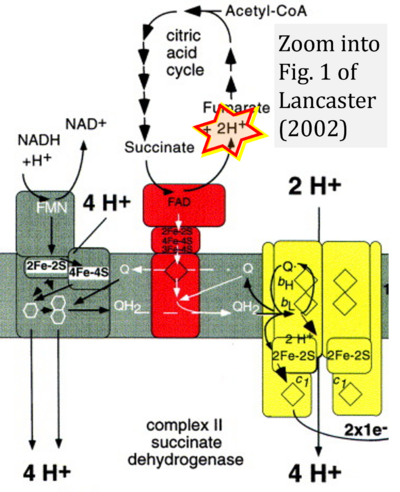Lancaster 2002 Biochim Biophys Acta
From Bioblast
| Lancaster CR (2002) Succinate:quinone oxidoreductases: an overview. Biochim Biophys Acta 1553:1-6. https://doi.org/10.1016/s0005-2728(01)00240-7 |
Lancaster CR (2002) Biochim Biophys Acta
Abstract: Succinate:quinone oxidoreductases (SQORs, EC 1.3.5.1) are enzymes that couple the two-electron oxidation of succinate to fumarate (reaction 1) to the two-electron reduction of quinone to quinol (reaction 2):
succinate → fumarate + 2H+ + 2e- (1)
quinone + 2H+ + 2e- → quinol (2)
• Bioblast editor: Gnaiger E
- The 2H+ in reaction 1,
- succinate → fumarate + 2H+ + 2e- (1)
- has an entirely different meaning as the H+ in NADH + H+ shown in Figure 1a. In this figure, fumarate + 2H+ shown besides NADH + H+ is ambiguous [1].
- 1. Gnaiger E (2023) Complex II ambiguities ― FADH2 in the electron transfer system. MitoFit Preprints 2023.3. https://doi.org/10.26124/mitofit:2023-0003.v4
Hydrogen ion ambiguities in the electron transfer system
Communicated by Gnaiger E (2023-10-08) last update 2023-11-10
- Electron (e-) transfer linked to hydrogen ion (hydron; H+) transfer is a fundamental concept in the field of bioenergetics, critical for understanding redox-coupled energy transformations.
- However, the current literature contains inconsistencies regarding H+ formation on the negative side of bioenergetic membranes, such as the matrix side of the mitochondrial inner membrane, when NADH is oxidized during oxidative phosphorylation (OXPHOS). Ambiguities arise when examining the oxidation of NADH by respiratory Complex I or succinate by Complex II.
- Oxidation of NADH or succinate involves a two-electron transfer of 2{H++e-} to FMN or FAD, respectively. Figures indicating a single electron e- transferred from NADH or succinate lack accuracy.
- The oxidized NAD+ is distinguished from NAD indicating nicotinamide adenine dinucleotide independent of oxidation state.
- NADH + H+ → NAD+ +2{H++e-} is the oxidation half-reaction in this H+-linked electron transfer represented as 2{H++e-} (Gnaiger 2023). Putative H+ formation shown as NADH → NAD+ + H+ conflicts with chemiosmotic coupling stoichiometries between H+ translocation across the coupling membrane and electron transfer to oxygen. Ensuring clarity in this complex field is imperative to tackle the apparent ambiguity crisis and prevent confusion, particularly in light of the increasing number of interdisciplinary publications on bioenergetics concerning diagnostic and clinical applications of OXPHOS analysis.
Labels:
Enzyme: Complex II;succinate dehydrogenase



